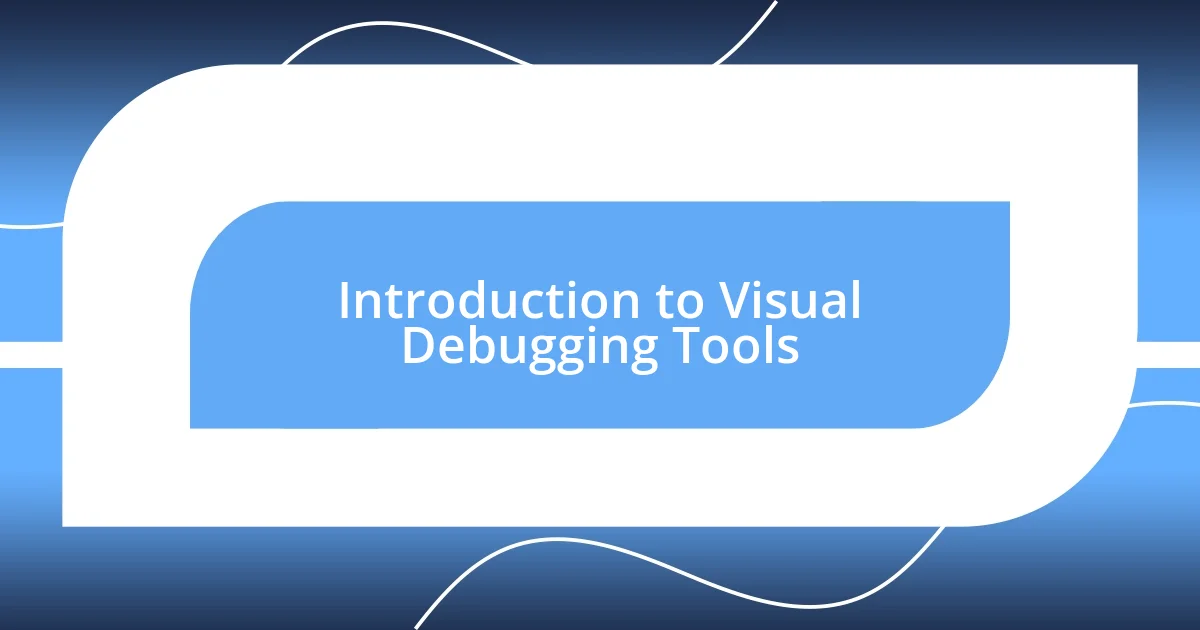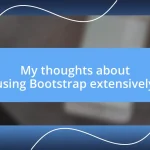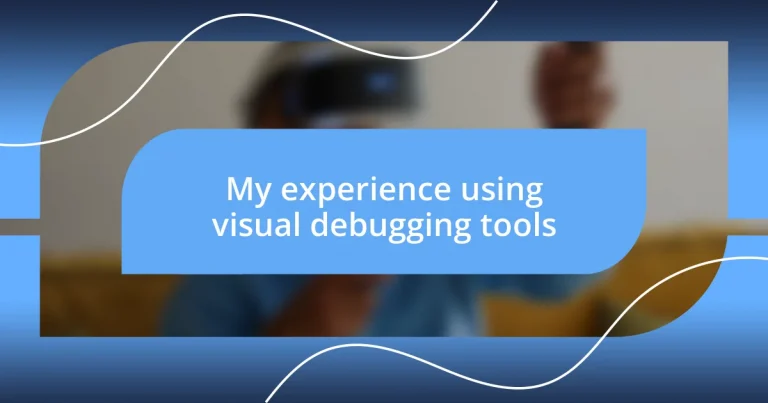Key takeaways:
- Visual debugging tools enhance problem-solving by providing real-time insights, making it easier to identify bugs and understand code functionality.
- Common challenges include tool compatibility, steep learning curves, and interpreting visual data, which can be mitigated through research, focusing on one feature at a time, and creating cheat sheets.
- Sharing visual debugging experiences fosters collaboration and mentorship, turning coding sessions into valuable learning opportunities for both experienced and junior developers.

Introduction to Visual Debugging Tools
Visual debugging tools revolutionize the way we approach problem-solving in programming. I remember the first time I used one; it felt like someone turned the lights on in a dark room. Instead of sifting through lines of code, I was able to visually map out my program’s flow, making bugs stand out like red flags.
The beauty of these tools lies in their ability to provide real-time feedback. Have you ever found yourself stuck, unsure of where your code is going wrong? I have been there countless times. With visual debugging, I can see exactly where things are breaking down, allowing me to not just fix the issue but also gain a deeper understanding of my code’s functionality.
Moreover, these tools often allow for straightforward, interactive exploration. I still recall the moment I realized I could hover over variables and see their values update in real-time. This kind of engagement transforms debugging from a burdensome chore into an enlightening experience, where learning happens naturally along the way. It’s truly fascinating how something so visual can enhance our cognitive grasp of abstract processes, isn’t it?

Benefits of Visual Debugging Tools
Using visual debugging tools brings a multitude of benefits that can significantly enhance the coding experience. From my perspective, one of the most impactful aspects is the instant clarity they provide. I recall a particularly frustrating bug in a project I was working on; traditional debugging methods left me feeling like I was lost at sea. With visual tools, I could swiftly identify the flow of execution and the values of variables at each step, making the entire process feel more controlled and manageable.
Here are some key advantages of using visual debugging tools:
- Immediate Insights: These tools highlight issues at a glance, reducing the time spent searching for bugs.
- Interactive Exploration: Users can click, drag, and explore their code’s structure, making it engaging and informative.
- Enhanced Understanding: Visual representations help clarify complex logic, leading to better coding practices.
- Collaboration Made Easy: Sharing visuals with teammates can provide context, leading to quicker resolutions of issues together.

Common Challenges and Solutions
When using visual debugging tools, I often encounter issues with tool compatibility across different development environments. It’s frustrating when a tool that works beautifully in my local setup fails to integrate with the deployment environment. One solution I found effective is researching community feedback on various tools to ensure compatibility before committing to one. Experience has shown me that keeping an open dialogue with peers can also lead to discovering alternative approaches that streamline the debugging process.
Another common challenge is the steep learning curve associated with some visual debugging tools. When I first started using them, I felt overwhelmed by the array of features and options available. To overcome this, I focused on mastering one feature at a time. I started with basics like breakpoints and slowly graduated to more complex functionalities. It’s all about pacing yourself and not getting discouraged. I think that approaching these tools as a personal challenge can actually make learning enjoyable.
I also sometimes struggle with interpreting the visual data, especially when it feels like a maze of information. Initially, I would stare at the graphical representations, often missing the bigger picture. A practical solution I adopted was creating a cheat sheet of common visual cues and their meanings. This practice helped me bridge the gap between raw data and actionable insights, enabling me to make quicker decisions based on what I was seeing.
| Challenge | Solution |
|---|---|
| Tool Compatibility | Research and peer feedback on compatibility |
| Steep Learning Curve | Focus on one feature at a time |
| Interpreting Visual Data | Create a cheat sheet for visual cues |

Case Studies and Practical Examples
One memorable instance from my experience with visual debugging tools occurred during a team project where we were integrating a new API. The documentation wasn’t crystal clear, and we faced an odd bug that left us scratching our heads. I decided to use a visual debugger, which transformed our debugging session. Suddenly, we could see the API calls and responses in real time; it felt like a light bulb went off! The clarity we gained not only helped us fix the bug but also fostered a collaborative atmosphere as everyone could grasp the flow of data together.
In another scenario, while refining a complex logic branch in an application, I faced a moment of frustration. I kept going in circles, but when I switched to a visual representation of the code, it felt like my perspective shifted. The tool laid out the decision paths clearly. I often wonder, how many times I would’ve saved myself from extensive hours of confusion if I had utilized this approach sooner? It reminded me that insight isn’t just about finding bugs; it’s also about understanding the entire code landscape holistically.
Additionally, I remember the first time I shared a visual debugging session with a junior developer on my team. As I walked her through identifying issues visually, I saw her confidence grow with each solved problem. Witnessing her “aha!” moments was incredibly rewarding. Sharing not only the tools but also the thought process behind them turned a standard debugging session into a valuable learning experience. It emphasized to me that using visual debugging tools isn’t just about fixing errors; it’s an opportunity for mentorship and growth, both for myself and my colleagues.














